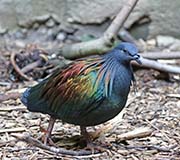Nicobar Pigeon - Caloenas nicobarica
| Length | |
| Weight | |
| Clutch Size | |
| Chicks at birth | |
| IUCN Conservation Status | |
Continents: |
The Nicobar Pigeon is found in Southeast Asia. They are considered a "Near Threatened" species because their numbers are declining due to humans hunting them for food, the pet trade, using their gizzard stone for jewelry and degradation of their environment.
Nicobar Pigeons have a rather small head, long legs, long wings and a short tail. Their heads are blue grey. The neck feathers are also a blue grey and look like a mane. Their body is a mixture of grey and metallic green, blue and hints of copper. Their undertail is white. On the base of the bill near the forehead, they have a black knob. Females are slightly smaller, have browner underparts, and the knob on their bill is smaller.
Diet: Nicobar Pigeons eat seeds, fruit, buds, and grain. They have a gizzard stone to grind up the hard food items. They feed off of the ground searching through the leaves and digging with their bill. Like other pigeons, Nicobar Pigeons immerse their bill in water and suck it up instead of sipping water and then holding up their head to swallow it like most other birds.
Courtship: The courtship ritual consists of the male bowing and cooing to the female. This ritual can last a few days. They are believed to be monogamous and mate for life.
Nesting: Nicobar Pigeons build their twig nests in dense forests on small wooden offshore islands. These islets are usually uninhabited. They usually form large colonies. The male finds the nesting site, provides the nesting material and the female makes the nest. The female lays 1-2 eggs and both parents incubate the eggs. The chicks are altricial (helpless at birth) and are initially fed crop milk that the female regurgitates.
Habitat and Range: The Nicobar Pigeon is found in Southeast Asia including India, New Guinea, Malaysia, Indonesia and the Philippines. They prefer mangroves and lowland forests.
Vocalization: Not a vocal bird but when they do, they coo.
Plumage/Molt: No alternate plumage.
Migration: Nicobar Pigeons don't migrate but they do move from island to island in flocks and are considered nomadic. They usually roost on small predator free islands and fly to other places searching for food. Unlike other pigeons, Nicobar Pigeons usually fly in columns or single file, not in a loose flock.
Tongue/feet:
Bibliography:
- http://en.wikipedia.org The Free Encyclopedia, Accessed June, 2012
- http://whozoo.org Fort Worth Zoo, Accessed June, 2012
- http://www.honoluluzoo.org Honolulu Zoo, Accessed June, 2012
- http://birdlife.org BirdLife International, Accessed June, 2012







